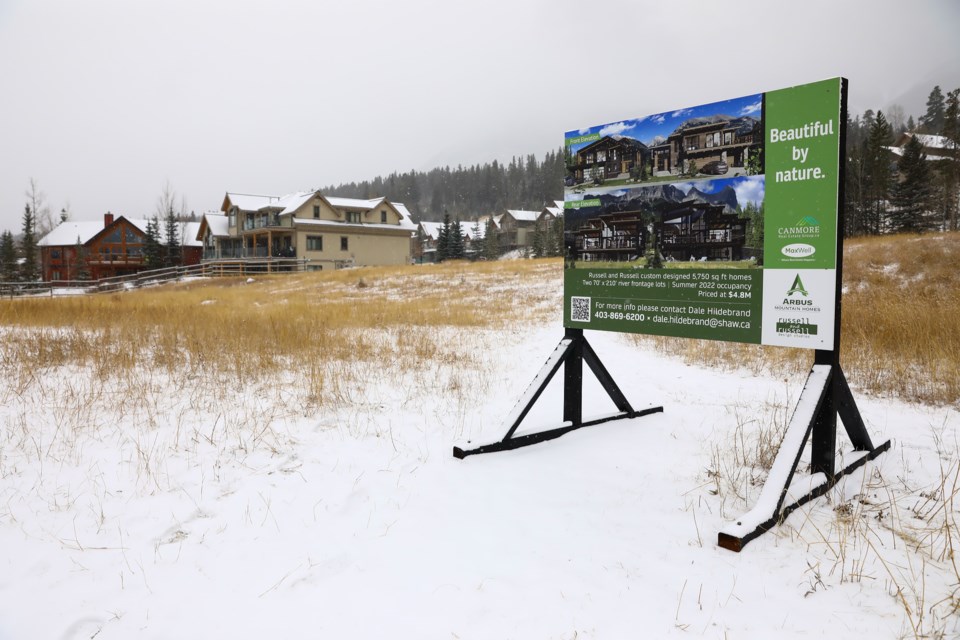CANMORE – Canmore's elected officials have voted in favour of establishing a direct control district for several homes along Van Horne in an effort by residents of the neighbourhood to formalize a 60-metre setback from the Bow River.
The Van Horne direct control district received second and third reading on Nov. 17 after a public hearing was held on Nov. 3. The application was made by residents of the neighbourhood to create the district under the Land Use Bylaw (LUB), which would only affect seven properties that have backyards facing the river.
Planner Alaric Fish presented the district to council for consideration at second reading and summarized the input received at the public hearing, including a desire by residents who own lots that have already been developed to see consistent rules applied to the future development of two vacant lots.
Fish explained the issue the proposed direct control district is trying to address is the setback from the river. In the past, homes that backed onto the river along Van Horne were approved for development with a 60-metre setback from it – although this history of how that was done over the past 30 years was not straightforward.
However, two vacant lots being considered for development along Van Horne would not be subject to the same setback under the current LUB. The legislation in place when the two lots were purchased for $6 million would only require a 7.5 metre setback.
"At the public hearing we heard a number of speakers and correspondence in support of the proposed bylaw," Fish said, adding the reasons for support of the change included maintaining regulatory consistency, protecting views and wildlife, and maintaining an orderly streetscape.
Those who opposed the bylaw, including legal counsel for the owners of the two vacant lots, argued that a direct control district was not appropriate as it sought to illegally limit the ability of the private property owner from developing their land, thus resulting in a financial uncertainty and a potential loss of value.
"They raised a number of concerns around appropriateness of a direct control district, the degree of public interest versus private interest, especially in light of the intent of the application," Fish said.
He pointed to the Municipal Government Act, as the appropriate legislation that gives council the authority to make planning and development decisions. The act sets out the purpose of planning regulations is to "achieve the order, economical and beneficial development, use of land and patterns of human settlement, and to maintain and improve the quality of the physical environment within which patterns of human settlement are situated in Alberta."
However, the MGA further states that this is to be done "without infringing on the rights of individuals for any public interest except to the extent that it is necessary for the overall greater public interest."
Fish told council that it would have to consider if the issues raised by the proponents have merit for the greater public interest beyond the limitation it would create for the private property owner.
"Administration believes there is a benefit to the greater public with respect to the adjacency of development to the trail, but there are detriments to other landowners, which are private interests," he said.
Coun. Joanna McCallum noted that protecting views is not something the Town of Canmore does through its development regulations. She also noted that the land between the edge of the private lots and the river is not technically part of any existing wildlife corridor or habitat patch in the valley.
McCallum put forward successful amendments to the district purpose statement to remove reference that it would preserve existing viewsheds and facilitate wildlife movement.
"I think it would be in the best interest of the bylaw to have that removed," she said. "We know wildlife move in the area, but it is not a wildlife corridor and I would not want to set expectations by keeping that in the purpose statement of the bylaw."
McCallum made further successful changes to the bylaw to ensure its permitted and discretionary uses aligned with those in the R1 district, and in particular that building a single detached dwelling is a discretionary use unless it includes an accessory dwelling unit.
In voting to approve the direct control district, as amended, Mayor John Borrowman said he considered the application from the perspective of a member of the community that uses that trail on a regular basis.
"It is one of the nicest trails we have in town and it is heavily used," he said. "It is such a rewarding experience as a trail user ... I feel this bylaw as amended will provide greater benefit to the community that uses that area recreationally."
Councillors Vi Sandford, Karen Marra and Jeff Hilstad all spoke to the importance of maintaining a consistent streetscape design for already established neighbourhoods like Van Horne.
"This still allows ample room for a reasonably sized building," Sandford said.
The wider of the two lots – 14 Van Horne – currently has a real estate listing for a single detached dwelling, still to be built, for $4.8 million. The two-storey, 4,250 square foot home is proposed to have seven bedrooms and five bathrooms. However, it is subject to a subdivision approval, which is expected in the near future from the subdivision authority.




